P:O.V. No.2
Closure in The Third Man:
on the dynamics of an unhappy ending
Richard Raskin
|
Jeezes, couldn't we make a shot where the girl gets together with the
fella?
| |
David O. Selznick |
|
The various changes that were made as The Third Man evolved from
Graham Greene's original treatment to the final result in Carol Reed's film,
have already been described in some detail by Adamson (1984), Moss (1987) and
Wapshott (1990), and will not be outlined here once again.
Only one major change will be mentioned: at the conclusion of Greene's
treatment, Martins catches up with Anna as she leaves the cemetery. They walk
together and are finally seen with her hand through his arm, which inspires the
narrator (Calloway) to remark, among other things, that Martins had a way with
girls.[1] In stark contrast to this happy
ending, Reed's film concludes with a remarkable shot lasting over a minute,
with Martins leaning against a wagon in the left foreground as Anna approaches
from a great distance, getting progressively closer, and - without so much as a
glance in his direction - finally walking past him and out of frame. Martins
then lights a cigarette and in exasperation, throws the match to the ground,
after which the picture fades to black (Figures 1-10). The strains of Karas's
zither music are heard throughout the shot.
Figure 1
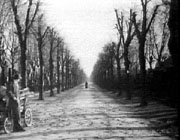
At 10 seconds
| Figure 2
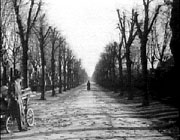
At 0 seconds
|
Figure 3
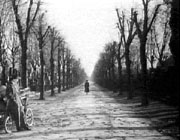
At 20 seconds
| Figure 4
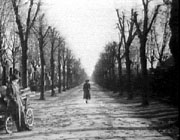
At 30 seconds
|
Figure 5

At 40 seconds
| Figure 6
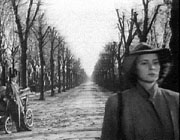
At 44 seconds
|
Figure 7
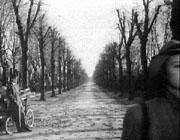
At 45 seconds
| Figure 8
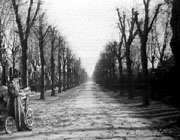
At 50 seconds
|
Figure 9
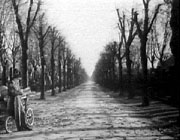
At 60 seconds
| Figure 10
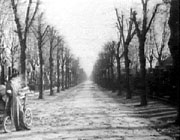
At 65 seconds: puffing smoke and
tossing the match, just before fade out.
|
Before the picture was completed, Graham Greene argued against this ending, for
two reasons: first, because he believed that The Third Man, which he
considered nothing more than an entertainment, was "too light an affair to
carry the weight of an unhappy ending"; and second, because he was
afraid that "few people would wait in their seats during the girl's long walk
from the graveside towards Holly, and the others would leave the cinema under
the impression that the ending was still going to be as conventional as my
suggested ending of boy joining girl."[2]
Carol Reed told Greene that the original ending, with Martins and Anna walking
arm in arm from the cemetery immediately after Harry Lime's burial, "would
strike the audience [...] as unpleasantly cynical."[3] Reed gave other reasons as well in a later
interview, in which he also mentioned producer David O. Selznick's desire for a
happy ending:
At one time it was thought that every picture must end with an embrace so that
the audience could go out happy, but I don't think that's what it did. A
picture should end as it has to. I don't think anything in life ends 'right'
[...] In The Third Man, Graham Greene wanted Joseph Cotton to overtake
Valli in that car; then the film would finish with the couple walking down the
road. I insisted that she pass him by. David Selznick had some money in the
film (I think it took care of Cotten and Orson Welles' valet). I must say he
was very nice and appreciative about the picture as soon as he saw it, but he
said, "Jeezes, couldn't we make a shot where the girl gets together with the
fella?" "It was in the original script," I said. "We chucked it out." "I'm not
sure. It was a good idea." But I mean, the whole point with the Valli character
in that film is that she'd experienced a fatal love - and then along comes this
silly American![4]
Once he had seen the film, Greene graciously conceded that Reed had been proved
"triumphantly right," and that he (Greene) "had not given enough consideration
to the mastery of Reed's direction," nor could he have anticipated the role
that Karas's zither music would play in that final scene.
While virtually everyone who writes about The Third Man hails the ending
as one of the most mesmerizing in the history of the cinema, those commentators
who interpret Anna's walking past Martins at the end generally view it
as an expression of the filmmakers' negative judgment of Martins. In other
words, the ending is seen by a number of commentators as appropriate and
satisfying because it is precisely what Martins deserves! The most extreme
interpretation of this kind was proposed by Andrew Sarris (1957):
Martins attends Lime's funeral, and waits by the side of the road to speak to
Lime's mistress. In one of the most memorable endings ever filmed, the girl
walks deliberately past Martins, into the camera and beyond while Martins
lights a cigarette to conceal his discomfiture. Suddenly, all the disquieting
elements in this thriller fall into place, and new layers of meaning rise above
the surface. Holly Martins has been repudiated by Reed and Greene as well as by
Lime's mistress.
[...] With a different final sequence, The Third Man would lose much of
its intellectual force.[5]
Sarris then goes on to suggest, absurdly, that Martins' real reason for killing
Harry Lime in the sewers was the resentment he felt because Anna had "rudely
dismissed" his advances.
Yet, when Martins shoots Lime at the end, he is able to convince himself that
he is acting out of the noblest of motives. Martins lacks the self-awareness to
realize that his mediocrity conditions his sense of outrage at the evil deeds
of a superior human force (op. cit., pp. 11-12).
Having been torn between a personal loyalty to Lime and a moral obligation to
help the authorities arrest him, Martins finally allows his social conscience
to take precedence over personal considerations, and that - according to Sarris
- is what justifies an ending in which Martins is duly punished for his
betrayal of Lime: "The point that Reed and Greene make [...] is that moral
responsibility is personal rather than social, especially in a world that has
gone awry " (p. 12).
Other critics, though adopting a more moderate stance, followed Sarris' lead in
viewing the ending as in some sense either deserved by Martins or enhancing
Lime's status in our eyes. They include Voigt (1974),[6] Adamson and Stratford (1978),[7] Palmer and Riley (1980)[8] and Moss (1987).[9]
Moss, for example, characterizes Martins as "a clumsy and misguided idealist
whose unworldliness has deadly ramifications for other people" (p. 181). It is
his meddling and inability to cope with the complexities of a dangerous world,
which result in the deaths of three men: the porter, Sergeant Paine and Harry
Lime. According to Moss
the movie-makers seem convinced of the ineffectuality of goodness, whose pale,
limp passivity is contrasted throughout with the striding vigour of evil, at
once cunning and robust [...] Predictably, Anna prefers the memory of Harry to
the reality of Martins (pp. 184-185).
Moss's enthusiasm for the sheer artistry of the ending - a "devastatingly
bleak, idiosyncratic conclusion" which displays "an aesthetic boldness
unparalleled in English language films, the gamble of a remarkable artist" -
goes hand in hand with his view that the "last moments of the film are
courageously true to the intellectual and emotional logic of the story" (p.
191).
Taking issue with critics such as Sarris "who condemn Martins and champion
Lime," Lynette Carpenter (1978)[10] argues
that when Martins gets a closer look at Harry's victims in the children's ward,
and finally "agrees to sacrifice personal loyalty to social responsibility,"
this "commitment to help Calloway marks the final stage of a maturing process
that begins when he steps off the train in Vienna" (p. 30). For Carpenter, "the
film systematically attempts to persuade the audience to accept this decision
along with Martins" (p. 27), and "advocates humanity and compassion in the face
of increasing pressure to categorize, generalize and dehumanize, a pressure
that leads, when unresisted, to totalitarianism" (p. 31).
Sarris's nonsensical claims about Martins' shooting of Lime, are also refuted
by Carpenter who points out that "when Lime kills Paine in the sewers, Martins
goes after him in a moment of anger; but when Martins kills Lime, he does so
out of compassion for Lime's suffering. Thus his final gesture is in keeping
with his awakened humanity" (p. 31).
If you believe as I do that Carpenter is right about the implicit value system
of the film, and that within the framework of the fiction as Greene and Reed
have defined it, Martins does what any decent person would do in his situation,
there is still the question of the ending to contend with, since in this
context, the ending appears entirely unfair. And if that is the case, then
why do we like it?
McFarlane (1993)[11] attempts to account for
our willingness to accept the ending, despite the fact that it does not
reward Holly's moral victory by bringing him together with Anna, as a Hollywood
film would most likely have done. In this connection, McFarlane makes two
points: first, as had already been suggested by Driver (1989/90),[12] there may be a more truthful statement about
love in this ending than is usually found in more conventional films; and
second, "the audience may accept Anna's walking away because of the satisfying
moral rightness of the climax in the sewers" (p. 22).
Both of these points may well be valid, but they can at best explain why we
accept the ending, not why we find it satisfying. In the remainder of this
article, I will try to point out some of the qualities of the ending which may
help to account for its appeal. First, however, the final shot will be replaced
in its context, beginning with the burial of Harry Lime.
Figure 11
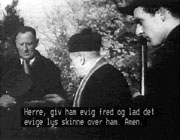
Priest: Anima ejus, et animae omnium
fidelium defunctorum, per misericordiam
Dei requiestcant in pace.
| Figure 12
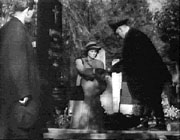
Anna drops a spoonful of earth on the
coffin.
|
Figure 13
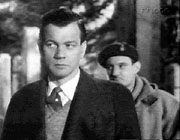
| Figure 14
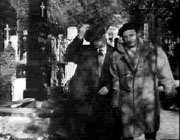
|
Figure 15
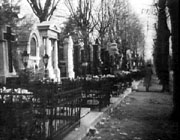
| Figure 16
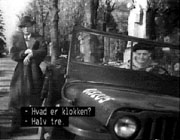
Calloway (climbing into the jeep):
What time is it? Martins: 2:30.
|
Figure 17
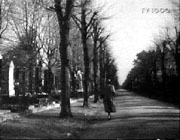
| Figure 18
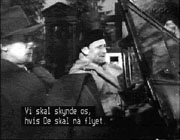
Calloway: I'll have to step on it
if you're going to catch that plane.
|
Figure 19
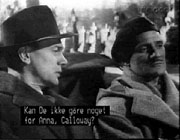
Martins: Calloway, can't you do
something about Anna?
Calloway: I'll do what I can, if she'll let
me.
| Figure 20
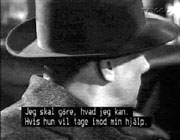
The camera tracks in for a close shot of
Martins as he turns to look at Anna.
|
Figure 21a
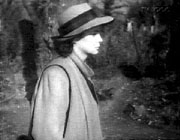
Anna seen from Martins' p.o.v. at the
start of the shot.
| Figure 21b
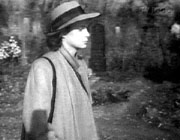
One second into the shot.
|
Figure 21c
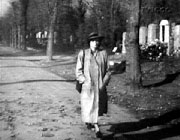
Two seconds into the shot.
| Figure 21d

Three seconds into the shot.
|
Figure 21e
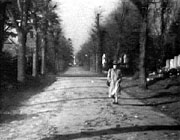
Four seconds into the shot.
| Figure 21f
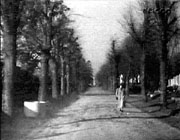
Five seconds into the shot.
|
Figure 21g

Six seconds into the shot.
| Figure 22
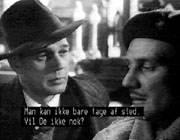
Martins: Wait a minute, let me out.
Calloway: Well there's not much time.
Martins: One can't just leave. Please.
|
Figure 23
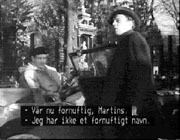
Calloway: Be sensible Martins.
Martins: I haven't got a sensible name,
Calloway.
| Figure 24
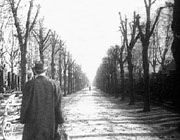
Martins takes his position, leaning up
against the wagon.
|
Figure 25
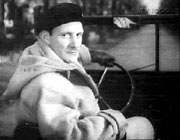
Calloway looks back at Martins, then
drives off.
| Figure 26
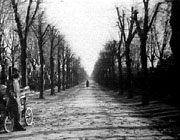
The beginning of the final shot.
|
That Anna would never accept Holly Martins as her lover has been made
abundantly clear to us in the scene in which Holly shows up drunk at her
apartment, late at night, and he declares his love for her.
Holly: Oh, I don't know. I'm just a hack writer who drinks too much and
falls in love with girls... you.
Anna: Me?
Holly: Don't be such a fool. Of course.
Anna: If you'd rang me up and asked me whether you're fair or dark or
had a mustache, I wouldn't have known.
[...]
Holly: I make comic faces and I'd stand on my head and grin at you
between my legs and tell all sorts of jokes... Wouldn't stand a chance, would
I? (Tears roll down Anna's cheeks.) You did tell me I ought to find myself a
girl.
Earlier in the same scene, Holly tries to interest Anna's cat in playing with
him, but the cat jumps off Anna's bed, totally uninterested in Holly, who
remarks: "Not very sociable, is he." Anna then replies, "No, he only liked
Harry." Although this bit about the cat was added primarily as a way of letting
us know some moments later that the man waiting below in the doorway - against
whose shoe the cat snuggles - is none other than Harry, it also expresses in a
symbolic fashion the hopelessness of Holly's position in relation to Anna's
life.
As if all that weren't enough, Holly's prospects for even remaining on civil
terms with Anna are dramatically worsened when she realizes, on two occasions,
that he has been cooperating with Calloway in setting a trap for Harry. First,
at the railroad station, at which time she says to Holly: "Look at yourself in
the window - they have a name for faces like that." And later, in the
café to which Harry is being lured, when the last words she speaks to
Holly are: "Honest, sensible, sober Holly Martins. Holly, what a silly name.
You must feel very proud to be a police informer." And that was before
Lime's death.
One this basis, we have been fully prepared to understand not only that
Martins' love for Anna was utterly hopeless from the start, but also that now,
after Harry's death, she would want nothing to do with the man who pulled the
trigger.
Furthermore, when Holly replies to Calloway "I haven't got a sensible name"
(Figure 17), this serves as a reminder of Anna's final insult to Holly at the
café, and helps to reinforce one last time our expectation that Anna
will want no part of him.
When she finally walks past Holly, without even glancing in his direction, we
perceive her behavior as the fulfilment of an inevitability, the enactment of a
necessity, confirming our expectations even more fully than we had imagined
possible. (This did not prevent us from hoping, all the time, that somehow she
might still accept Holly, though we knew - as he did - that it would never
happen.)
At the same time, however, the way in which this outcome is staged, filmed and
left uncut is so extraordinary that we are stunned by its originality, even on
the tenth or twentieth viewing of the film. Reed's use of an uninterrupted take
lasting over a minute, filmed with a stationary camera, and allowing the
outcome to unfold in so gradual a manner, with Holly simply standing there as
Anna completes her foreseeable trajectory, is unlike any other ending ever
filmed. As the shot continues, we keep wondering whether it will actually go on
in real time as it had begun, with no cutting, no camera movement, no close
shot of Holly, no spoken lines. This is the "æsthetic boldness" and
"gamble of a remarkable artist" to which Moss rightly referred.
What we have then in the final 66 seconds of the film is a shot which clinches
an inevitable and necessary outcome yet does so in a way that is utterly
unexpected. In other words, the conclusion of the story is experienced
as the fulfilment of an inevitability, while the cinematic discourse
with which the story is concluded takes us by surprise. This unique interplay
of inevitability and surprise is just one of the properties of the ending that
make it unforgettable.
As many commentators have pointed out, Harry's two funerals "bookend" the film,
establishing a symmetrical relationship between the beginning and end of the
story. And as is well known, that kind of symmetry, in which the story comes
full circle, returning to its point of departure, is one of the most effective
devices for achieving closure.
But other symmetries as well play an important role in that connection. For
example, the shot of Anna seen from Holly's point of view as Calloway drives
him from the cemetery at the end (Figure 21a-g) has a parallel in a similar
shot following Harry's first burial. And even more important is the fact that
the shot in Figure 15a-g shows Anna getting progressively smaller on the
tree-lined road from the cemetery, as the distance between her and the camera
increases. This is the exact opposite of what will happen in the final shot
(Figures 1-10), when on the same road, she gradually approaches the camera and
progressively fills a larger portion of the screen - the two shots, though of
different durations (6 and 66 seconds), standing nevertheless in a symmetrical
relationship to one another.
Yet another symmetry is equally important, this time within the final
shot: the bilateral symmetry of the picture composition, with the road flanked
by trees on both sides, and the treetops and roadsides forming a double apex,
at the point of which Anna first appears as a dot in the distance. She will
then advance in the center of the picture, veering to the right foreground only
when she reaches the camera. Although Holly's position in the foreground left
is an asymmetrical element within the picture, the various bilateral symmetries
are nevertheless striking, and help to give this shot a memorable look.
From the time Anna first appears in the distance until about 40 seconds into
the shot when she begins to veer to our right, she occupies the center of the
screen and is also the primary focus of our attention, though we occasionally
glance over to Holly, to watch him watching and waiting for Anna.
After she walks past him, Holly becomes the sole focus of our attention, and
for the remaining 20 seconds of the shot, the picture has no center or rather
the center is empty. This displacement of our focus, from center to periphery,
and our sense that the center is now irretrievably gone, serves as a closural
device, giving us twenty seconds more within which we can get used to the fact
that the story has now run its course, that nothing more will happen, and that
we must now let go of the fiction.
Giving those final 20 seconds some small measure of content, Reed had Joseph
Cotten light a cigarette, then toss the match onto the ground.[13] That gesture in turn serves as the final
punctuation - the period or full stop - for the scene and for the film as a
whole, which now fades to black.
Yet another source of richness within the final scene are the binary
oppositions running through it: Holly's immobility is played off against Anna's
unstoppable propulsion forward, just as Holly's concern for Anna ("One can't
just leave") is played off against Anna's icy indifference toward him.
Within the framework of these oppositions, things are pushed to their outer
limit and set in stark relief, strongly profiling Holly and Anna in their final
two shot.
Throughout the final shot, leaves continue to fall onto the road. For
Moss (op. cit., p. 191), this was a "curtain of autumnal leaves [...] creating
a last image of the decay that has played such a formidable part in the film's
ambiance." Another possibility is to see the falling leaves as a metaphor for
sadness[14] and for the ending phase of a
life-cycle - in this case, the ending of the relationship between Holly and
Anna, and the ending of the film.
The zither music was specifically mentioned by Greene as one of the
elements in the final shot which made it so successful. It is the only sound
heard from the time Holly takes up his position at the wagon, waiting for Anna.
When only music is heard for so long a period, that in itself can serve as an
increasingly unmistakable signal that the dialogue in the film is over and that
the film itself is only moments away from its conclusion. This is yet another
closural device, cushioning the moment of imminent separation from the film and
helping us to let go of the fiction.
<
Returning now to the point of departure in this discussion, I have argued in
favor of viewing Holly at the conclusion of the film as a character thoroughly
deserving of our admiration. Unlike Sarris and others who, as Carpenter rightly
put it, "condemn Martins and champion Lime," I cannot find the outcome in
itself as one Martins deserves, and have therefore tried to understand why
despite that unjust outcome, the ending of The Third Man is so
satisfying.
In attempting to do that, I have suggested that the ending draws its appeal
from a number of factors, including: a unique interplay of inevitability and
surprise; a number of symmetries enhancing closure and enriching our visual
experience of the final shot; changes at the center of the shot and in the
focus of our attention; salient binary oppositions; the falling leaves as
metaphor; and the zither music.
Virtually all of these aspects of the final scene are the products of Carol
Reed's imagination and craftsmanship and owe little to Graham Greene, who
opposed the ending on which Reed insisted. Anyone who has looked closely at the
ways in which Reed managed the closure of this film, will understand why
Michael Winner wrote:
If people tell me: "I want to be a film director," I say, "You don't need to go
to film school. Just watch The Third Man 100 times.[15]
Adamson, Judith. Graham Greene and the Cinema. Norman, Oklahoma:
Pilgrim Books, 1984.
Adamson, Judy and Philip Stratford. "Looking for the Third Man on the Trail in
Texas, New York, Hollywood," Encounter (June 1978), pp. 39-46.
Clem. "The Third Man," Variety (7 September 1949).
Carpenter, Lynette. "I Never Knew the Old Vienna: Cold War Politics and The
Third Man," Film Criticism (1978), pp. 27-34.
Cook, Christopher. "Hijacking The Third Man," Listener 116, 2991
(18-25 December 1986).
Crosby, John. "The Second Man," Observer (1 June 1969).
Crowther, Bosley. "The Third Man," New York Times (3 February 1950).
Denby, David. "Night World" in Favorite Movies. Critics' Choice, ed.
Philip Nobile. New York: Macmillan, 1973, pp. 87-96.
Driver, Paul. "A Third Man Cento," Sight and Sound 59, 1 (Winter
1989/90), pp. 36-41.
Falk, Quentin. Travels in Greeneland. The Cinema of Graham Greene.
London & New York: Quartet Books, 1990; orig. pub. 1984.
Gomez, Joseph A. "The Third Man: Capturing the Visual Essence of
Literary Conception," Literature/Film Quarterly 2, 4 (Autumn 1974), pp.
334 -340.
Greene, Graham. "Sir Alexander Korda," Sight and Sound 25, 4 (Spring
1956), pp. 214-215.
Greene, Graham. The Third Man and The Fallen Idol. Harmondsworth:
Penguin, n.d.
Greene, Graham. The Third Man. London: Faber and Faber, 1988; orig. pub.
1973.
Greene, Graham. The Third Man. New York: Bantam Books, 1962; orig. pub.
1950.
Greene, Graham. Ways of Escape. London: The Bodley Head, 1980.
Lambert, Gavin. "The Third Man," Monthly Film Bulletin 16, 189
(September 1949), p. 159.
Man, Glenn K. S. "The Third Man: Pulp Fiction and Art Film,"
Literature/Film Quarterly 21, 3 (1993), pp. 171-177.
Manvell, Roger. The Film and the Public. Harmondsworth: Penguin, 1955.
McFarlane, Brian. "The Third Man: Context, Text and Intertextuality,"
Metro Magazine 92 (Summer 1993), pp. 16-26.
Moss, Robert F. The Films of Carol Reed. London: Macmillan, 1987.
Palmer, James W. and Michael M. Riley. "The Lone Rider in Vienna: Myth and
Meaning in The Third Man," Literature/Film Quarterly 8, 1
(1980), pp. 14-21.
Parkinson, David (ed.). Mornings in the Dark. The Graham Greene Film
Reader. Manchester: Carcanet, 1993.
Pogue, Leland. "The Third Man" in International Dictionary of Films
and Filmmakers, vol. 1: Films. Chicago: St. James Press, 1984; pp.
891-2.
Samuels, Charles Thomas. Encountering Directors. New York: G. P.
Putnam's Sons, 1974.
Sarris, Andrew. "Carol Reed in the Context of His Time," Film Culture 3,
1 (1957), pp. 11-15.
Sarris, Andrew. "First of the Realists. An Analysis of Carol Reed's Work for
the Cinema (Part I)," Films and Filming 3, 12 (September 1957), pp.
9-10, 32.
Sarris, Andrew. "The Stylist Goes to Hollywood. An Analysis of Carol Reed's
Work for the Cinema (Part II)," Films and Filming 4, 1 (October 1957),
pp. 11-12, 30.
Taylor, John Russell (ed.). The Pleasure Dome. Graham Greene: The Collected
Film Criticism 1935-1940. London: Secker & Warburg, 1972.
Van Wert, William F. "Narrative Structure in The Third Man,"
Literature/Film Quarterly 2, 4 (Autumn 1974), pp. 341-346.
Voigt, Michael. "Pictures of Innocence: Sir Carol Reed," Focus on Film
17 (Spring 1974), pp. 17-34.
Wapshott, Nicholas. The Man Between. A Biography of Carol Reed. London:
Chatto & Windus, 1990.
Winner, Michael. "Every Shadow Tells a Story," Independent (7 October
1994), p. 24.
Wright, Basil. "A Study of Carol Reed" in The Year's Work in Film 1949,
ed. Roger Manvell. London: Longmans, Green, 1950; pp. 11-22.
[1] Graham Greene, The Third Man
and The Fallen Idol (Harmondsworth: Penguin, n.d.), p. 119.
[2] Preface to The Third Man, in Greene's Ways of Escape
(London: The Bodley Head, 1980), p. 124. A less complete version of this text
is included in 1950 Heinemann and subsequent Penguin editions of The Third
Man and The Fallen Idol.
[3] Graham Greene, ibid.
[4] Charles Thomas Samuels, Encountering Directors (New York:
G. P. Putnam's Sons, 1974), pp. 169-170.
[5]
Andrew Sarris, "The Stylist Goes to Hollywood." Films and Filming 4, 1
(October 1957), p. 11.
[6] "The film's remarkable ending [...] is a clear indication of its
attitude. Martins may have made the right decision morally, but it's difficult
to feel much affection for him." Michael Voigt, "Pictures of Innocence: Sir
Carol Reed," Focus on Film 17 (Spring 1974), p. 28.
[7] "The Anna who walks away leaving Holly behind her is a more valid
character than the one in the story who capriciously slips her hand through his
arm. She remains faithful to Harry Lime, and his figure, in consequence,
becomes larger and more difficult for the audience to contend with." Judy
Adamson and Philip Stratford, "Looking for the Third Man on the Trail in Texas,
New York, Hollywood," Encounter (June 1978), p. 40.
[8] "Reed and Greene neither dismiss Holly nor exactly pronounce
judgment on him. Rather, they achieve a vision that reckons with both his
virtues and his vices." James W. Palmer and Michael M. Riley, "The Lone Rider
in Vienna: Myth and Meaning in The Third Man," Literature/Film
Quarterly 8, 1 (1980), pp. 19-20.
[9] Robert F. Moss, The Films of Carol Reed (London: Macmillan,
1987).
[10] Lynette Carpenter, "I Never Knew the Old Vienna: Cold War
Politics and The Third Man," Film Criticism (1978), pp. 27-34.
[11] Brian McFarlane, "The Third Man: Context, Text and
Intertextuality," Metro Magazine 92 (Summer 1993), pp. 16-26.
[12] Paul Driver, "A Third Man Cento," Sight and Sound 59, 1
(Winter 1989/90, pp. 36-41.
[13] Joseph Cotten described the filming of the final moments of this
shot as follows: "I remained there, as directed, still smoking the cigarette.
My eyes followed Valli out of the shot and, anticipating Carol's shout of
"Cut," I almost strolled back to my chair to wait for the assistant to announce
"One more, please," or for Carol to say, "Print." Nobody uttered a word. The
camera kept rolling. The special effects men from their high perches continued
to drop toasted autumn leaves from above. I continued to puff on my cigarette,
and began to get quite panic-stricken. Was there more to the scene? Had I gone
blank? What was Carol waiting for me to do? I took one more puff, then in
exasperation threw the cigarette to the ground, at which point Carol shouted
through his laughter the word I had been waiting desperately to hear - 'Cut.'"
Though Cotten speaks of throwing the cigarette to the ground, he may
actually be referring to the match he throws to the ground in
exasperation just before the picture fades to black. This text is in the press
booklet published when a new 35mm print of The Third Man was released on
March 18, 1994. The press booklet is available on the micro jacket for The
Third Man at the BFI library.
[14] J. C. Cooper, An Illustrated Encyclopedia of Traditional
Symbols (London: Thames and Hudson, 1984), p. 96.
[15] Michael Winner, "Every shadow tells a story," The
Independent (7 October 1994), p. 24.































